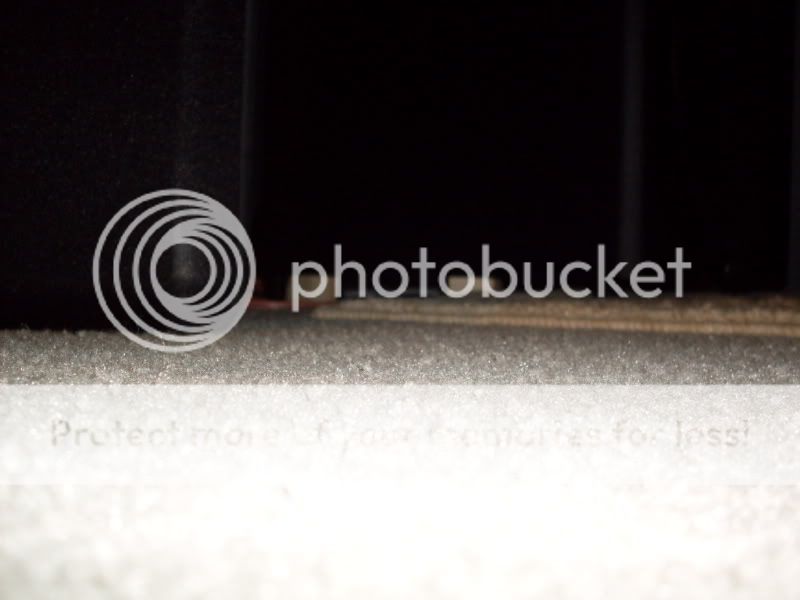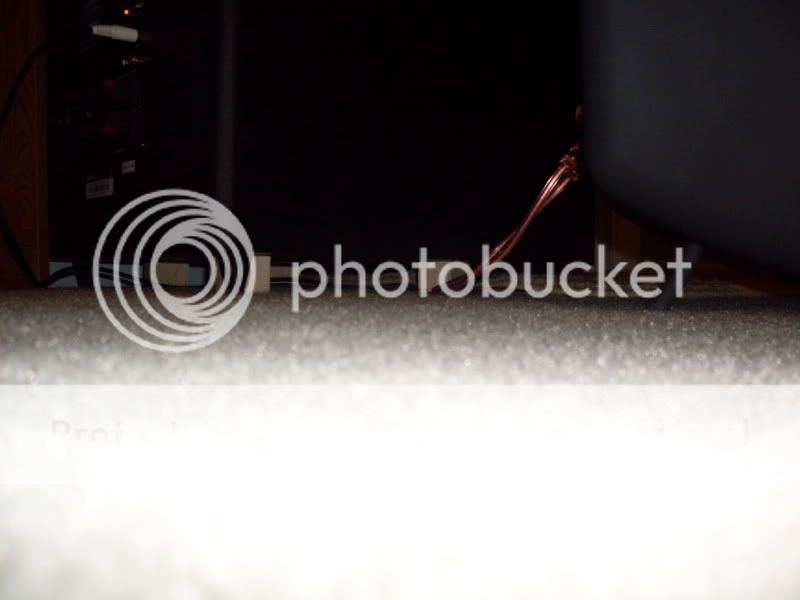BUILDING SUBWOOFER RISERS
Many people report better bass response by raising their subwoofers. One of the most popular products for this purpose is the Auralex Isolation Risers
Gramma & Great Gramma,
Subdude, and
SubdudeHD. According to Auralex, Gramma stands for
Gig and
Recording,
Amp and
Monitor,
Modulation
Attenuator. I have no idea what that name means.

 Gramma Specifications:
Gramma Specifications:
23" long x 15" wide x 2.75" high
Weight Limit: 300lbs.
Market Price: $50
Great Gramma Specifications:
30" long x 19" wide x 2.75" high
Weight Limit: 300lbs.
Market Price: $80
Subdude:
15” x 15” x 2 3/4”
Market Price: $50
Subdude HD:
15" x 15" x 2.5"
Market Price: $60
Where to Buy
http://store.audioholics.com/section/66443/1/auralex
http://www.sweetwater.com/store/detail/GRAMMA
http://www.sweetwater.com/store/detail/GreatGRAMMA/
http://www.sweetwater.com/store/detail/SubDude
http://www.sweetwater.com/store/detail/SubDudeHD/
Isolation Pads from Elemental Designs (4" Height, from $55 to $85):
http://www.edesignaudio.com/index.php?cPath=2_126
Auralex Mopad, $39.95:
http://www.sweetwater.com/store/detail/MoPAD
Auralex SpeakerDudes, $40:
http://www.sweetwater.com/store/detail/SpeakDudeHD
Low cost alternatives:
http://shop.mapleshadestore.com/products.asp?dept=1
http://meniscusaudio.com/bvd-feet-p-744.html
Reviews:
http://www.hometheaterhifi.com/volum...ma-4-2004.html
http://namm.harmony-central.com/WNAM...at-GRAMMA.html
http://www.amazon.com/Auralex-GRAMMA...owViewpoints=1
http://www.sweetwater.com/store/detail/GRAMMA/reviews/
http://www.zzounds.com/productreview--AURGRAMMA
I decided to make my own subwoofer isolation risers for two of my box-type front-firing subwoofers. In the spirit of the B.S. from Auralex, I decided to call them Grampa (
Gyration
Rhapsody
Ass
Moped
Physical
Amplifier).


According to Houghton Mifflin Dictionary:
Gyration: Circular or spiral motion. An oscillation or varying between states.
Rhapsody: Exalted or excessively enthusiastic expression of feeling in speech or writing. In music, a usually instrumental composition of irregular form that often incorporates improvisation.
Ass: Any of several hoofed mammals, resembling and closely related to the horses but having a smaller build and longer ears, and including the domesticated donkey. A vain, self-important, silly, or aggressively stupid person. The buttocks.
Moped: A lightweight motorized bicycle that can be pedaled as well as driven by a low-powered gasoline engine.
Physical: Of or relating to the body as distinguished from the mind or spirit. Of or relating to matter and energy or the sciences dealing with them, especially physics.
Amplifier: A device, especially one using transistors or electron tubes, that produces amplification of an electrical signal.
For the top, I used high quality Birch 3/4" plywood and for the legs, I used standard 2x4 wood. The size of each subwoofer riser is 20" by 20". Instead of plywood, you can use 3/4" MDF wood.
I drilled holes about 2.5" apart and attached the top to the legs with long screws.
Next, I cut the carpet to size and used 3M heavy duty spray glue to attach the carpet to the top.
For the bottom, I used staples to attach the carpet to the board.
It is a good idea to fill the space between the the two legs with
1/2" Acoustic Foam or
1" Acoustic Foam.
Regular foam is not effective in absorbing the lower frequencies. If you want your riser to also act as a sub trap, build a 2 feet riser and fill the inside with rigid fiberglass or mineral wool. Wrap the surrounding of the riser with carpet or grill fabric.
You can also buy much cheaper solid foam from fabric stores, craft stores, mattress stores, or Wal-Mart. The one from Wal-Mart is 15" x17" with a thickness of 2". It looks like the following picture, but smaller.
This is a picture of the finished risers.
This is one of the risers under the Acoustic Audio 12" subwoofer.
After the risers were finished, I added new legs to them and increased their height by 6". I also added more dampening foam to the bottom. Now, I have to paint the legs and cover everything with carpet.
Additionally, you can add rubber vibration isolation pads or spikes to the bottom of the legs.
http://www.av-outlet.com/index.html?...tml&lang=en-us
http://stores.ebay.com/South-Florida...=p4634.c0.m322
http://stores.ebay.com/PARTSPIPE/Flo...=p4634.c0.m322
http://www.soundproofcow.com/sound-i...n-control.html
http://www.drillspot.com/tag/vibration-isolator/
http://www.fullcompass.com/product/316672.html
http://www.fullcompass.com/product/239266.html
http://www.fullcompass.com/product/239265.html
http://www.fullcompass.com/product/239264.html
http://shop.ebay.com/items/?_nkw=spe...ikes&_osacat=0
http://www.parts-express.com/wizards...hFilter=spikes
If you get desparate, you can go to a sporting goods store and buy a few hockey pucks.
 ROUND SUBWOOFER RISERS
ROUND SUBWOOFER RISERS
I was so happy with the results of the square risers described above that I decided to build two round subwoofer risers for my two cylindrical Hsu subwoofers. I am sure you realize that building a round riser is a much more difficult task. I decided to call them the
Round Great Grampa Subwoofer Risers. Here is a pictorial summary:
These are the wooden tops. The diameter of each one is 24" to accommodate the 23.5" diameter of the Hsu subs.
These are the attached legs. The length of each leg is 6".
After the legs were fully attached, I covered the tops and the legs with carpet and attached dampening foam to the bottom. I used the 3M spray glue to attach the carpet to the top and used staples to attach the carpet to the bottom of the wooden top and the legs.
I then attached 4" legs to the subwoofers. The subs already had metallic spikes. I was not very happy with them as they were two short and I was worried about scratching the wood floor.
I bought 16 Buttkicker RI-K28-4 Small Vibration Isolators from
AV Outlet for the four subwoofers/risers in my HT room. The cost was $7.99 per package of 4 for a total cost $31.96 + Free shipping.
Go to
AV Outlet, on the left hand side, click on Seat Shaker & Amplifiers, and then click on Rubber Vibration Isolators for Chair and Platforms.
This is a picture of the back of the isolators.
I attached the isolators to the legs of the risers with wood screws.
I then carried the heavy subs and put them on top of the round risers.
The final step was to run test signals and calibrate them again. With my old and reliable SPL meter in hand, I turned the receiver’s test tones. As soon as I heard the test tones through the 4 subwoofers, I jumped about 6 feet into the air. It was so much louder than before. Even my wife noticed it in the next room. Wow....just wow!!!

I am not exaggerating. It was almost 10db’s higher than before. Immediately, I had to run and turn the volume of all the subwoofers down. After I completed the calibration, I played some CD’s and could not believe that such a simple and inexpensive (about $20 to $30) riser can make such a huge difference.
I HIGHLY RECOMMEND THEM TO EVERYBODY.
Did I notice a change in the bass response because of the rubber isolators? Well, I tried to measure the perfromance before and after with my SPL meter. There may have been a difference of 1 or 2 dB, but that can be due to error. I felt that there was a very small amount of tightness, but it could be due to placebo.
For $8 per subwoofer I bought peace of mind and hopefully I managed to silence the naysayers who have been complaining that the DIY risers do not decouple the subwoofers effectively from the floor. Personally, I think decoupling from the floor is over-rated.



Raising the subwoofer and dealing with vertical axial mode is far more important.

How High a Riser?
Theoretically, if your ceiling is 8ft high, you can go up to 2 feet. However, when you raise it that high, you should really fill the gap under the riser with dense material. Take a look at these SubTraps from ASC.
18” SubTrap (50 Hz) Standard, most Subwoofers: $469
22” SubTrap (30 Hz) Large Subwoofer: $586
http://www.asc-home-theater.com/subtrap.htm
Quote:
|
Once you hear the difference, you’ll never go back. The SubTrap is more than a simple isolation stand. In addition to isolation, it absorbs excess bass and decouples your sub-woofer from room mode. The end result is a unique product available only from ASC. Raise your subwoofer up to its full performance potential. Just slip the ASC-SubTrap underneath your subwoofer and you’ll create the powerful “SubStack.” Instantly improve bass detail, changing “muddy” low frequency playback into a richly detailed picture. Not only does the SubTrap increase bass extension and punch, it also gets rid of "one note bass.
|
Quote:
|
By raising the sub off the floor and putting a SubTrap under it, the subwoofer is effectively decoupled from the vertical room mode. Excess bass buildup is reduced and the playback volume of the subwoofer can be cranked up much higher than before.
|
Reviews:
http://hometheaterhifi.com/volume_12...ap-6-2005.html
http://www.stereophile.com/musicinth...ic/index1.html
A LOW COST TWEAK FOR SPEAKERS
Here is another tweak for your speakers that does not send you to the poor house.
I have been thinking about putting something under my vintage Polk speakers. I have searched the internet and found crazy things for $300 or $400 each. I finally gave up and went to my favorite high-end audio/video tweak shop, Home Depot.

I went to the crown moulding department of Home Depot and bought these wooden mouldings. They come in different sizes. I bought 8 of the 2" x 2" mouldings for $1.10 each. They were on sale. I put them under the speakers for additional stability and decoupling from the floor. You can paint them if you want. I believe I noticed a slight improvement in midrange, but it could be placebo. For less than $5 per speaker, I am not going to worry about it.

























































 Raising the subwoofer and dealing with vertical axial mode is far more important.
Raising the subwoofer and dealing with vertical axial mode is far more important. 




 Are you going to build some isolators for your speakers too?
Are you going to build some isolators for your speakers too?






 From the ceiling ~ that would be A different thing to experience I'll bet !
From the ceiling ~ that would be A different thing to experience I'll bet ! 




 Linear Mode
Linear Mode

